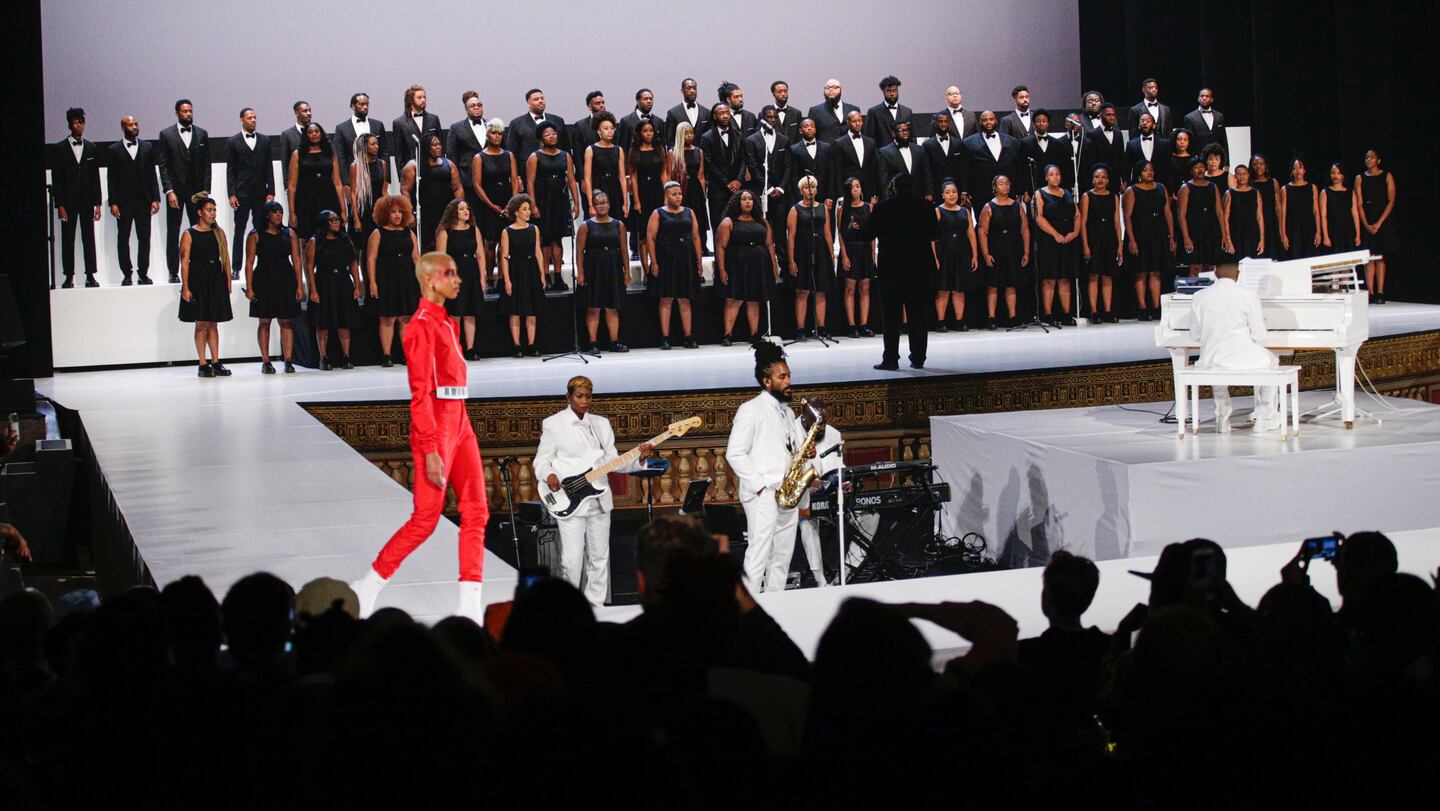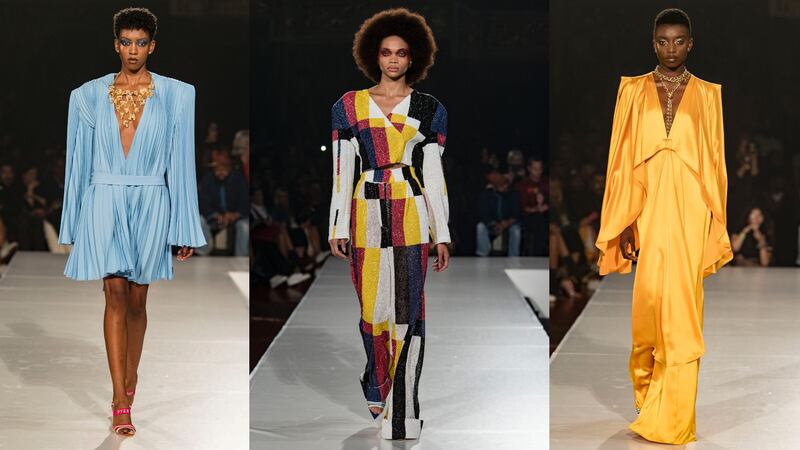
The Business of Fashion
Agenda-setting intelligence, analysis and advice for the global fashion community.

Agenda-setting intelligence, analysis and advice for the global fashion community.

NEW YORK, United States — When Brooklyn native Kerby Jean-Raymond was still in high school, he won a scholarship from Sean John that came with a ticket to the 2004 CFDA Awards, the year the label's founder, rapper Sean Combs, won Menswear Designer of the Year.
Sitting at the awards 16 years ago, he plotted his entrée into fashion. “I thought you had to be a rapper to make clothes,” he said backstage after his latest show, which took place deep into Brooklyn Sunday night at the historic Kings Theatre in East Flatbush, where he used to work across the street at Ragga Muffin, a shoe store.
Jean-Raymond didn’t have to be a rapper to become the hottest ticket at New York Fashion Week. But he is taking the opportunity he’s created for himself to do more than make clothes. For the third instalment of his trilogy of collections tackling the topic of blackness, he collaborated with Sean John as a thank you to Combs, but also as a way to spotlight another American brand rarely seen as such by the white establishment. (The first was Cross Colours, the second was FUBU.)
This was Jean-Raymond reclaiming the black experience in America. And it’s the most important thing to happen to American fashion in years, maybe even decades.
ADVERTISEMENT

Pyer Moss Spring/Summer 2020 | Source: INDIGITAL.TV
[ View CollectionOpens in new window ]
Jean-Raymond chose the Kings Theatre for many reasons. “I’ve been so traumautised in this neighbourhood for the past 18 years. I’ve been robbed here, I’ve been stabbed here, I’ve had fights here,” he said. “Now, I wanted to make it clear to people who are still here — and have made the place better and made their lives here — that I’m not afraid of home. Whatever those traumas were that were inflicted upon me don’t hurt me anymore, and they can’t hurt us anymore. Wherever you came from, don’t fear it.”
He spent $400,000 staging an event that drew a crowd of hundreds from the community that has formed around him — facilitated, in part by a long-term deal he has with Reebok — and sent a powerful message about what it means to be a black person living in America. "What it would look like if we have the resources to succeed like other races?" he asked. Jean-Raymond may have the attention of the Vogues and CFDAs of the world, but this show wasn't for them — it was for his community of young and creative black people looking for a symbol of their history and potential.
“Black people, when we get to a certain place of being established, we want to assimilate,” he said. “Rather than assimilate and leave, let me bring people back home, what’s home for me, and show that the pain that we used to know is not a figment of imagination, it's real. The pain doesn’t have to stop us from coming back.”
It began with a moving sermon about slavery and freedom from the author Casey Gerald, whom Jean-Raymond met in 2018 at BoF's Voices. "We are here tonight to claim our wings," Gerald said, walking up and down the squared-off catwalk in a pair of Pyer Moss Reeboks. Soon, the first of the models — many of which were cast on Instagram — emerged, walking to the sounds of a live black choir of 65 voices, the women dressed in simple black belted dresses and the men in tuxedos.
The collection, called Sister, retraced the work of Sister Rosetta Tharpe, the queer black woman who invented rock-and-roll in the 1940s but is rarely credited with having done so. It was the silhouette that stayed with you: the strong shoulders on a sequined, gridded dress, the sculptural, curved edges of a white poncho, the straight-line trousers worn with cowboy boots. It was rock-and-roll fashion if rock-and-roll had “stayed black,” Jean-Raymond said. These were his most sophisticated garments to date.
This is just all the outsiders. I ride for them and they ride for me.
Jean-Raymond, however, said he doesn’t care about selling clothes: “I care about keeping people employed. We could be making a lot more if we actually put shit out there, but I refuse to make anything without meaning.”
He doesn’t seem to have a grand plan for building a business that makes lots of money or becoming a creative director at a big fashion house. Instead, he is using his medium to work things out that normally sit for years in our heads.
ADVERTISEMENT
In the past, that’s meant designing shows around topics like depression, or financial anguish, or father-son relationships. His most recent shows have all been about the black experience in America: an opportunity to include the excluded.
“[Fashion is] an elitist sport, and now I’ve got all the kids that were told that you have to be Euro and present yourself in a certain way and delete parts of yourself and your culture and people and native land — who were told that was wrong and that wasn’t fashion — those people have somehow gravitated towards Pyer Moss because it’s open,” he said. “This is just all the outsiders. I ride for them and they ride for me.”
And yet, despite the industry accolades he’s amassed — a CFDA Award, an appointment to the trade organisation's board of directors — Jean-Raymond is reluctant to call himself an industry leader. “I haven’t led anything yet,” he said. “Call me a leader when I’m about to economically empower other young designers.”
But with the increased attention, Jean-Raymond has, in some ways, become the de-facto reference in the discourse on diversity and inclusion in American fashion, which can sometimes feel like he is being used.
“I’m not the race guy,” he said. “That’s not my schtick. I care about people.”
So many creative people are stunted because they are unable to get out of their own way, their hangups. Jean-Raymond's vulnerability — understanding that the process is the thing — has made his message so powerful. He’s already working on his next collection, a standalone concept he said he’ll show when and where he feels like it. Wherever that may be, the world, not just fashion, will be watching.
“Yes! Everything!” a fan said after the show. “It’s everything.”
Additional reporting by Chantal Fernandez.
Related Articles:
[ Reebok Deepens Ties With Pyer MossOpens in new window ]
[ The Way We Are Taught to Live Has to Change: Casey GeraldOpens in new window ]
[ Reebok Partners with Pyer Moss Designer Kerby Jean-RaymondOpens in new window ]
From where aspirational customers are spending to Kering’s challenges and Richemont’s fashion revival, BoF’s editor-in-chief shares key takeaways from conversations with industry insiders in London, Milan and Paris.
BoF editor-at-large Tim Blanks and Imran Amed, BoF founder and editor-in-chief, look back at the key moments of fashion month, from Seán McGirr’s debut at Alexander McQueen to Chemena Kamali’s first collection for Chloé.
Anthony Vaccarello staged a surprise show to launch a collection of gorgeously languid men’s tailoring, writes Tim Blanks.
BoF’s editors pick the best shows of the Autumn/Winter 2024 season.